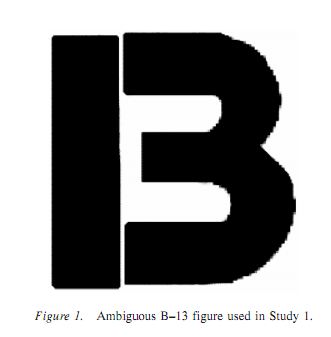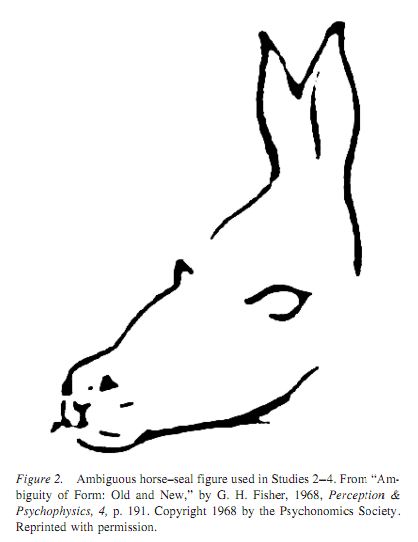I’m going to come out right now as a deconstructionist – I believe that everything we experience is shaped at least in part by our historical time and our social, physical, and psychological context. In other words, I don’t believe that when you and I look at the same object, we are actually seeing exactly the same thing. But don’t take my word for it. There is a lot of very interesting research coming out of the relatively young discipline of social vision which demonstrates that lots of things other than the objects or events we are looking at can impact what we actually perceive. I want to talk about a series of studies coming out of this line of research that I happen to think are very, very cool.
In a series of studies published in the Journal of Personality and Social Psychology (Balcetis & Dunnin, 2006), participants were shown an ambiguous figure. In one case, this was a figure that could be either interpreted as a B or a 13 (anyone remember the PEN15 club?).

Before showing them this figure, researchers told participants that if they saw a B on the screen, something good would happen (i.e., they would have to drink freshly squeezed orange juice), and if they saw a 13, something not so good would happen (i.e., they would have to drink a chunky, foul-smelling veggie smoothie). Participants were pretty highly motivated to see a B on the screen, which is exactly what they saw: participants were more likely to report seeing a B when seeing it was associated with a good outcome.

Now you might be thinking, “Of course they said they saw a B – they were just lying!” But we sneaky scientists preempt these kinds of things, so the researchers ran another study using images of an ambiguous animal which could be interpreted as a seal (corresponding to a bad outcome) or a horse (corresponding to a good outcome). They did the same thing in which they told participants that each type of image would correspond to a particular outcome and then showed them the ambiguous image. However, before asking the participants to report what they saw but after participants had already seen the ambiguous image, the researchers told the participant that they had made a mistake and that actually the horse corresponded to the bad outcome and the seal corresponded to the good outcome. They then asked participants to report what they had seen, and the researchers still found that participants were more likely to see a horse when it had originally been associated with the good outcome.
While I think these studies demonstrate in a very nice way that motivation impacts what we actually see, one could argue that this only applies when the thing you are seeing is really ambiguous, like with the B/13 or seal/horse images. However, other studies have shown that motivation and other non-visual factors impact things like the perceived steepness of a hill (see Proffit, 2006 for a review) or the perception of walking speed (Aarts & Dijksterhuis, 2002). Furthermore, lots of things in the world may be a lot more ambiguous than we sometimes believe. For instance, work by Kristin Pauker and her colleagues shows that motivation and other non-visual factors influence perceptions of race, both our own and others. My own work looks at out how things other than our sexual experiences may influence the way we think about our sexuality (e.g., Preciado & Peplau, in press).
I think a good lesson to learn from this work is that you should never take your own world view (both literal and figurative) for granted. The way we see things is not perfect truth – it’s shaped just as is everyone else’s.